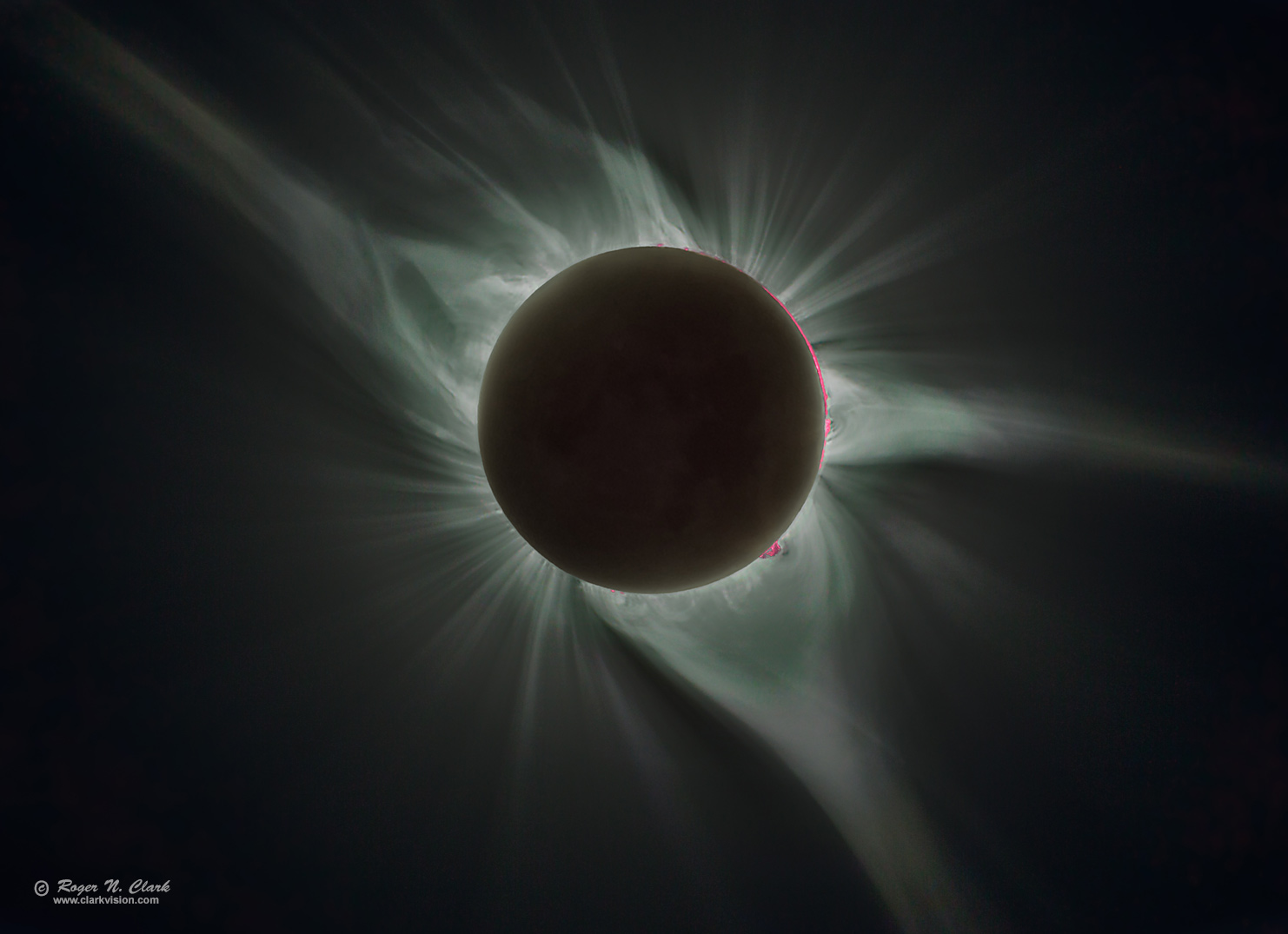| Home | Galleries | Articles | Reviews | Best Gear | New | About | Contact | Gallery Index | Previous |
Next |

| Home | Galleries | Articles | Reviews | Best Gear | New | About | Contact | Gallery Index | Previous |
Next |

Very intricate coronal detail is seen in this image of the August 21, 2017 eclipse. As each camera took images once every 2 seconds, I had an astonishing view of the pink prominences and greenish-gray corona. I could see some of this structural detail and might have been able to discern more if the duration of totality was longer. Fortunately the camera froze the moment, enabling us to see this amazing beauty. Everyone should see such a sight at least once in their lifetime. The structure in the corona is mainly due to charged particles in the Sun's magnetic field.
The green color is caused by iron XIV "Coronium" emitting at 530.3 nm in the green. The pink-magenta color in the prominences is due to hydrogen emission (Hydrogen-Alpha at 656.3 nm in the red, Hydrogen-Beta at 486.1 nm, blue-cyan, and Hydrogen-gamma at 434.1 nm in the blue). The colors in this image have been enhanced and contrast boosted over the natural color image. The reddish light from the Moon is sunlight reflected off of the earth to the Moon with its reddish color and back to us during the eclipse. A total solar eclipse marks the exact moment of New Moon.
Technical. The corona seen during a total eclipse has a very high dynamic range. Multiple exposures were needed by a camera to cover that range. I used Canon 6D 20-megapixel digital camera, with a 1.4x teleconverter and a Canon 500 mm f/4 telephoto lens on a fixed tripod. Exposures: 7 frames at 1/8 second, 3 frames at 1/25th second, 5 frames at 1/80 second, and 2 frames at 1/250 second, all at f/11, ISO 200. The multiple frames at the same exposure were aligned and stacked with sigma-clipped average and saved as 32-bit floating point images. Then each stacked image had a radial blur applied and 75% of the blur subtracted to enhance detail. Color corrections were made at each step to show the colors that came out of the camera. The radial blur was then applied again at 41% subtraction, and then a third time, and each step the intensity increased with the curves tool. Finally, Adaptive Richardson-Lucy deconvolution was applied to recover fine detail. The multiple processing steps also enhanced the color saturation. The different exposures were assembled and levels adjusted to give a consistent flow from bright inner to the faint outer corona. Full plate scale was 1.94 arc-seconds/pixel. The image is reproduced here at 4.8 arc-seconds/pixel.
For more information on the color of the solar corona, see: True colors of solar corona by Miloslav Druckmüller
See How to Photograph the Sun: Sunrise, Sunset, Eclipses for more details on solar eclipse photography.
To learn how to obtain stunning images like this, please visit my Extensive Articles on Photography .
Keywords to this image = astrophoto-1 the_sun eclipse canon_6d moon
Image ID: solar-eclipse-total-700mm-6d.c08.21.2017.IMG_0357-79c-detail2.b-c1-0.4xs.jpg
| Home | Galleries | Articles | Reviews | Best Gear | Science | New | About | Contact |
Last updated November 03, 2025